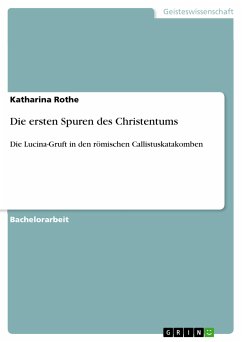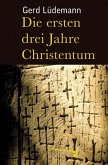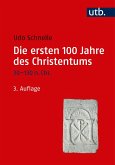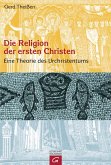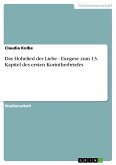Bachelorarbeit aus dem Jahr 2010 im Fachbereich Theologie - Historische Theologie, Kirchengeschichte, Note: 1,7, Europa-Universität Viadrina Frankfurt (Oder) (Professur für Alte Geschichte und Römische Verfassungsgeschichte beim Lehrstuhl für Mittelalterliche Geschichte Mitteleuropas und regionale Kulturgeschichte ), Veranstaltung: Die Stadtgeschichte Roms - Kulturgeschichte, Sprache: Deutsch, Abstract: This bachelor thesis deals with the topic of the Roman catacombs with a focus set on the Crypt of Lucina. These tombs can be seen as the first evidence of the origin of Christianity. At the same time they reflect the unique nameless belief of those days and its people. This belief is not comparable with the Christianity that is practiced in our days. In the course of this work I will describe and analyze how this anonymous belief is illustrated in the symbolic frescoes. Which influences of other cultures are integrated? What is new and Christian within the expression? Furthermore I have a critic view on the opinion of some scientists that the key of transcription to the pictures is lost. I argue that one is able to interpret most of the catacomb pictures of early Christian art with the use of the Bible, ancient texts of selected church fathers and the knowledge of the historical context. But, as one can see in the history of reception, it is necessary to be aware of the trap of dogmatic prejudices and keep an open style of interpretation. In my conclusion I gather from a few but central complexes of motifs taken from daily life that Christian belief was close to the ordinary folk. So it operated with symbols common to the crowd such as rural idyll, dining illustrations, the relationship of teachers and pupils and parables referring to the sacraments to demonstrate the hope of salvation. This idea was basic for the early Christian catacomb frescoes because of the temporal importance to this time and the connection to death in funerary art.
Dieser Download kann aus rechtlichen Gründen nur mit Rechnungsadresse in A, B, BG, CY, CZ, D, DK, EW, E, FIN, F, GR, HR, H, IRL, I, LT, L, LR, M, NL, PL, P, R, S, SLO, SK ausgeliefert werden.

